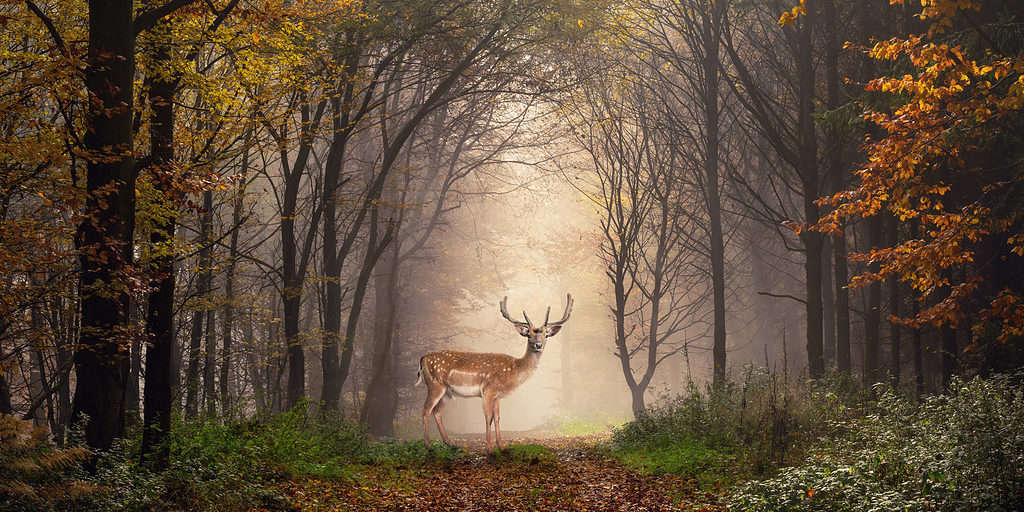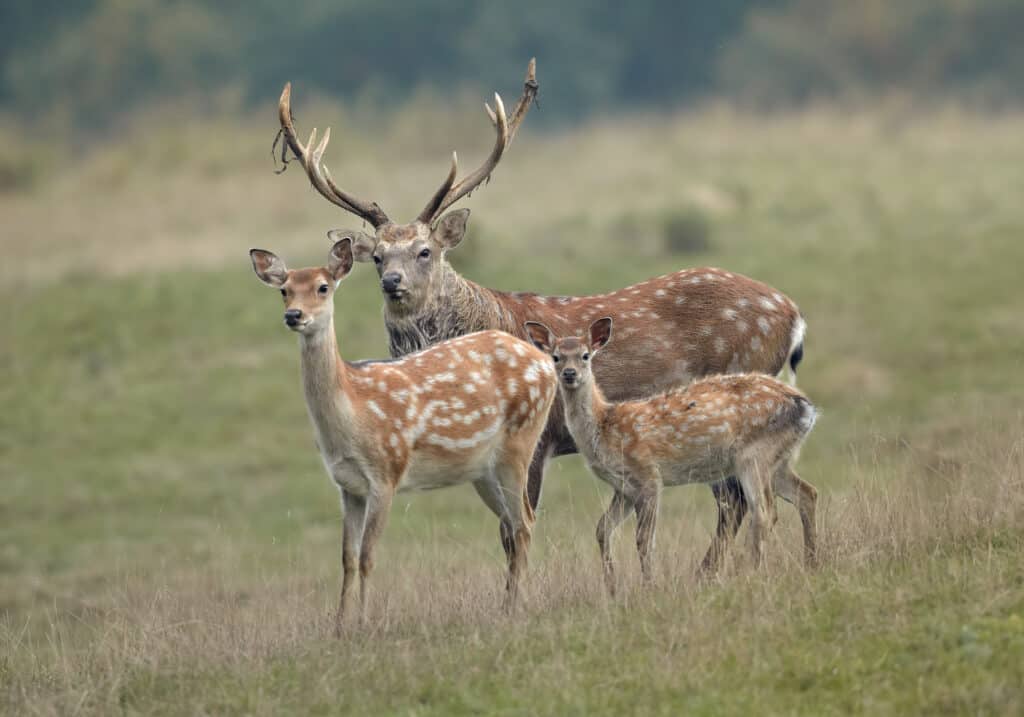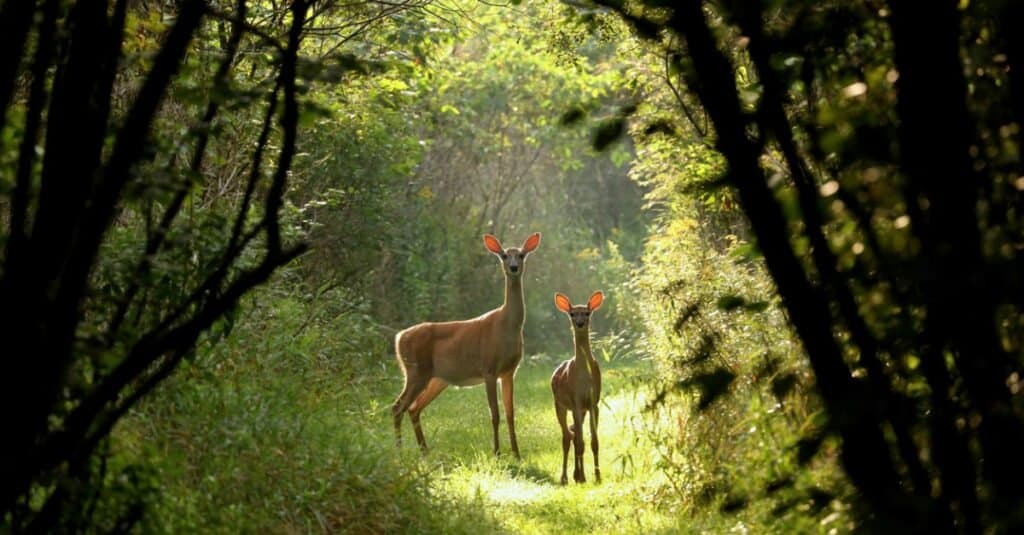
Native and Indigenous tribes often have specific spiritual beliefs surrounding nature and the creatures that live within it. But, of course, Indigenous tribes are not the only people with these beliefs. Norse, African, and Asian communities also have beliefs about the animals that inhabit the world and what they mean for the humans interacting with them.
A-Z Animals has compiled a collection of known shamanistic beliefs regarding the deer as a spirit animal, envoy, or other spiritual messenger or guide. These include ancient and modern ideas worldwide.
Disclaimer
The writer of this article is not of Native or Indigenous heritage. However, we have endeavored to find native-owned and native-sourced research sources for our article, which can be found below. This does not mean representing an authoritative source on Indigenous beliefs. We recommend speaking directly with Indigenous and First Nations people regarding their beliefs if you want a definitive opinion.
We must recognize that spirit animals are not toys or novelties. They are revered spirits to the Indigenous and First Nations peoples, and we, as outsiders, should treat the concept with the appropriate respect that one would give to the spiritual and religious beliefs of others. This is not something to play with. If you want to incorporate this belief into your own beliefs, do so respectfully.

Spirit animals are revered spirits to the Indigenous and First Nations peoples.
©Robert Schneider/Shutterstock.com
What Is a Spirit Animal? What Do Spirit Animals Represent?
A spirit animal is a teacher, messenger, or guiding spirit that reaches out to you during your life to guide you through it. You are not limited to just one spirit animal. Many spirit animals may visit you as you grow and adapt to the life you lead.
Spirit animals may visit you in real life or in dreams. When they do, they’ll take the form of an animal of their choice, typically the same animal every time they see you. They may appear during times of struggle when you need support or just be around to help you with little daily tasks.
While spirit animals have a general “symbolism” to them, they’re not like a Zodiac sign; they don’t say anything about who you are inside. In this sense, many people misunderstand what spirit animals are meant to represent. If you’re ever in doubt, remember: spirit animals are messengers, teachers, and guides, not who you are.
What your spirit animal means to you will be unique to your relationship with it. As you develop your relationship with your spirit animal, you will imbue a meaning for your spirit animal within yourself.

Spirit animals may visit you in real life or in dreams.
©Smileus/Shutterstock.com
Spirit Animal vs. Birth Totem
Some Indigenous tribes have a belief system commonly referred to as “birth totems,” which we’ll cover below. This belief system is more similar to the Zodiac, and which animals are included differs between tribes.
Birth totems are typically determined by the day and time of birth, just like Zodiac signs for the West or East. However, not all tribes use birth totems, and not all tribes have deer as one of their birth totems. So it’s important to remember which tribe’s beliefs your birth totem comes from if you have one. We also recommend only “having” a birth totem if it is bestowed to you by an Indigenous or First Nations person.
Birth totems may be used to determine your “path” in life and help you discover more about the person you are inside. However, unlike your spirit animal, your birth totem may only appear to you sparingly, especially if your birth totem animal is elusive or otherwise uncommon.
Spirit Animal vs. Power Animal
Another vital animal that may appear to you in Indigenous cultures is a power animal. Like spirit animals, you aren’t limited to just one power animal. Power animals are spirits you invoke when you need their mystical, shamanistic abilities. For instance, a medicine man may invoke the spirit of the fox — a commonly medicinal animal thought to lead medicine men to medical herbs — while treating a patient.
Indigenous Deer Spirit Symbolism
The meaning of a deer spirit will change based on the tribe you’re interacting with. However, there is a general meaning that one can derive from the presence of the deer in their life. Most of the time, the deer represents grace, gentleness, and intuition.

For many tribes deer represent grace, gentleness, and intuition.
©Martin Mecnarowski/Shutterstock.com
Lakota
The Lakota have great respect for the deer. Deerskins are an essential part of clothing production for the Lakota tribe. Additionally, they make for a delicious and hearty dinner. However, deer are difficult to hunt because of their powerful senses of smell and sight. As a result, unskilled hunters often find themselves utterly outwitted by deer in their early hunts.
Deer are also thought to be shapeshifters in Lakota traditions. Often, young men are led astray by a deer disguised as a young woman. Her intoxicating perfume will lead the young man away from his home, where she transforms back to her true form as a deer.
When this happens, legends say that the young men are overwhelmed with a desire to commit suicide and that those men who walk away from the deer unscathed bear unshakeable self-control and restraint.
Navajo
The Navajo revere the deer. They believe the creator formed the first man and woman in the world partly from deer hides. Special ceremonies must be performed before deer hunting and butchering because of the deer’s special relationship with the Navajo. Additionally, pregnant women and their husbands may not hunt deer or participate in deer butchering. Droppings, antlers, and untanned hides are not meant to be touched, especially by children.
Navajo also have somewhat similar beliefs to the Lakota tribe. They believe that the deer has the power to distract and lead people astray.
Cherokee
The Cherokee people have a more traditional view of the deer spirit. They believe the deer represents gentleness, compassion, caringness, kindness, subtlety, and innocence. They also view the deer as a bringer of adventure. So, in Cherokee tradition, you’ll see the deer at the beginning of your next new adventure.
How to Honor Your Spirit Animal
Honoring your spirit animal is an extraordinary and personal experience. How you choose to honor your spirit animal is up to you and is determined by your relationship with your spirit animal. However, there are some common ways that spirit animals are honored in Indigenous traditions.
Indigenous people often create beadwork featuring their spirit animal to wear on their regalia. Ceremonial dancers will also incorporate their spirit animals into their dances by assuming the posture and form of their spirit animal during their dances.
Beliefs of Other Lands
Deer are present in the beliefs of other lands. Many peoples, including the Norse, Japanese, and Kurdish people, have their own beliefs about the origins and meaning of the deer spirit and the presence of deer in one’s life.

The Norse, Japanese, and Kurdish people, have their own beliefs about the origins and meaning of the deer spirit.
©iStock.com/Karel Bock
Norse
The deer doesn’t appear in many Norse myths. However, despite its sparse inclusion in Norse mythology, it still holds an extraordinary place for the Vikings. First of all, four deer lived near the Tree of Life, Yggdrasil. These deer nibbled on the leaves of Yggdrasil, causing her great pain. It is believed these four deer represented the four seasons.
Additionally, the deer Eikþyrnir stood atop Valhalla beside Odin, the Allfather. Finally, the god Freyr used a deer antler as his weapon. Initially, Freyr wielded the magical sword Sumabrandr but lost this blade in battle. After losing Sumabrandr, Freyr took up the antler of a stag as his weapon until he died in battle at Ragnarock.
In terms of symbolism for the deer, the Norse believed that the deer represented sensitivity and intuition. This belief comes from the deer’s gentle yet cunning nature and the sharp senses that help keep it safe from predators. To the Norse, the deer represents being kind and caring yet determined and unwavering simultaneously.
Japanese
The Shinto believe that the deer is a messenger from the gods. This belief is present in most of the Shinto religion’s texts. However, it is particularly strong in those who worship at the Kasuga Shrine in the Nara prefecture. A white-tailed deer is said to have arrived at the shrine as an envoy from god, thus becoming the symbol of the Nara prefecture.
Kurdish
The Kurdish revere the deer and believe that killing one will bring a person bad luck, as this animal is considered a saint in the service of God. The government of Kurdistan strictly forbids the hunting and killing of deer.
Slavic
Slavic people have a mythological figure known as Zlatorog or Goldhorn. Goldhorn is depicted as either a white chamois buck or an Alpine ibex. As the legend of Goldhorn states, a young hunter fell in love with and wooed a young woman by bringing her beautiful flowers. However, before they could wed, she was swayed astray by a merchant who gave her gold jewelry. In his desperation to win back the girl’s affection, the hunter is convinced to hunt Goldhorn and give her his horns.
The hunter finds and shoots Goldhorn, who drags its dying body towards a cliff face. The hunter’s companion urges him to catch Goldhorn before he can eat the magical medicinal flowers sprouting in Goldhorn’s trail of blood. However, the hunter is too late, and as he approaches Goldhorn, blinded by the bliss of its sparkling gold horns, he loses his balance and falls to his death.
Final Thoughts
Deer hold a special place in many different cultures’ traditions. No matter what mythos, especially ancient ones, you look at, you’ll often see deer included as they were so crucial to the survival of the ancient peoples. Once again, we want to remind people that these depictions of deer are not novelties or toys. These are actual spiritual beliefs that are important to many people. So please treat them with respect and reverence like any other religion.
The photo featured at the top of this post is © Nikki Zalewski/Shutterstock.com
Sources
- UniGuide, Available here: https://www.uniguide.com/deer-meaning-symbolism-spirit-animal-guide
- Legends of America, Available here: https://www.legendsofamerica.com/na-totems/
- National Museum of the American Indian, Available here: https://americanindian.si.edu/nk360/informational/native-american-spirit-animal
- Native American Vault, Available here: https://www.nativeamericanvault.com/pages/totem-animals-and-their-meanings
- We R Native, Available here: https://www.wernative.org/articles/spirit-animals
- Native American Jewelry, Available here: https://www.nativeamericanjewelry.com/native-american-birth-totems/
- Cherokee Billie Spiritual Advisor, Available here: https://cherokeebilliespiritualadvisor.com/pages/animal-totems-and-their-meanings-by-cherokee-billie
- Akta Lakota Museum and Cultural Center (1970) https://aktalakota.stjo.org/lakota_spirit_animal/deer-tȟaȟca/
- Forged in Valhalla, Available here: https://www.forgedinvalhalla.com/en-nl/blogs/news/meaning-of-deer-in-norse-mythology#:~:text=Deer%20is%20the%20symbol%20of,obstacles%20with%20speed%20and%20vigilance.
- Wikipedia, Available here: https://en.wikipedia.org/wiki/Deer_in_mythology#:~:text=Deer%20are%20considered%20messengers%20to,also%20sacred%20as%20divine%20messengers.
- Wikipedia, Available here: https://en.wikipedia.org/wiki/Goldhorn
- Natural History Museum of Utah (1970) https://baskets.nhmu.utah.edu/collections/symbols/deer-symbolism#:~:text=The%20Diné%20(Navajo)%20use%20all,back%20to%20a%20healthy%20lifestyle.
FAQs (Frequently Asked Questions)
What do deer spirits represent?
Generally, deer spirits represent gentleness, compassion, beauty, grace, and determination.
What are examples of deer spirits in mythology?
The Deer Woman in Native American mythos is just one example of deer represented in mythology. There are other examples, such as Goldhorn and Eikþyrnir from the Slavic and Norse mythos.
Do spirit animals exist in other cultures?
While the concept of animal spirits is present in the mythos of most regions, the spirit animal we’re most familiar with originates in the Native American and Indigenous communities.
What is a spirit animal?
In Native and Indigenous traditions, a spirit animal is a messenger or teacher that appears to you as an animal.
Thank you for reading! Have some feedback for us? Contact the AZ Animals editorial team.






